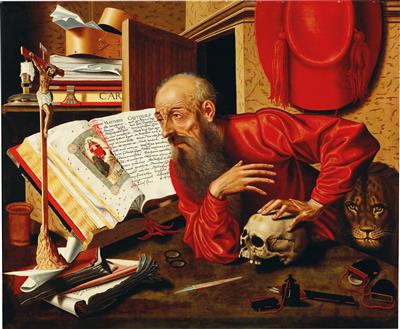Netherlandish School, 16th Century

Saint Jerome in his study,
oil on panel, 102 x 123 cm, framed
The present composition already enjoyed great popularity in the sixteenth century. It is therefore not surprising that numerous variants of it are known. Reymerswaele’s works are generally dated into the period between 1521 and 1560. They are characterised by a nervous drawing style, cool and vibrant colours, and physiognomies occasionally bordering on caricature. His paintings reflect the atmosphere prevalent during the Reformation. The best examples of his work are in the Museo del Prado and the Academia San Fernando, Madrid, in the Kunsthistorisches Museum, Vienna, in the Museum of Fine Arts, Antwerp, and in the Museo del Bargello, Florence. Reymerswaele headed a big workshop in order to cope with a huge number of commissions. From amongst the variants Friedländer classified as workshop replicas, none comes close to the present painting in terms of quality.
The Dutch painter Marinus Claesz. van Reymerswaele was influenced by Quentin Massys and Albrecht Dürer and was receptive to the social and religious themes of Lutheranism. Reymerswaele is documented to have been in Antwerp from 1509 onwards. Next to depictions of bankers, money changers, and tax collectors, all of whom are shown dressed in excessively fashionable clothes most carefully rendered down to the last detail, the theme of Saint Jerome in His Study numbers among the artist’s most popular compositions. His personifications of greed and avarice mentioned above were in great demand and even made him famous in Italy and Spain.
Expert: Dr. Alexander Strasoldo
 Dr. Alexander Strasoldo
Dr. Alexander Strasoldo
+43 1 515 60 403
oldmasters@dorotheum.com
17.10.2017 - 18:00
- Dosažená cena: **
-
EUR 116.067,-
- Odhadní cena:
-
EUR 40.000,- do EUR 60.000,-
Netherlandish School, 16th Century
Saint Jerome in his study,
oil on panel, 102 x 123 cm, framed
The present composition already enjoyed great popularity in the sixteenth century. It is therefore not surprising that numerous variants of it are known. Reymerswaele’s works are generally dated into the period between 1521 and 1560. They are characterised by a nervous drawing style, cool and vibrant colours, and physiognomies occasionally bordering on caricature. His paintings reflect the atmosphere prevalent during the Reformation. The best examples of his work are in the Museo del Prado and the Academia San Fernando, Madrid, in the Kunsthistorisches Museum, Vienna, in the Museum of Fine Arts, Antwerp, and in the Museo del Bargello, Florence. Reymerswaele headed a big workshop in order to cope with a huge number of commissions. From amongst the variants Friedländer classified as workshop replicas, none comes close to the present painting in terms of quality.
The Dutch painter Marinus Claesz. van Reymerswaele was influenced by Quentin Massys and Albrecht Dürer and was receptive to the social and religious themes of Lutheranism. Reymerswaele is documented to have been in Antwerp from 1509 onwards. Next to depictions of bankers, money changers, and tax collectors, all of whom are shown dressed in excessively fashionable clothes most carefully rendered down to the last detail, the theme of Saint Jerome in His Study numbers among the artist’s most popular compositions. His personifications of greed and avarice mentioned above were in great demand and even made him famous in Italy and Spain.
Expert: Dr. Alexander Strasoldo
 Dr. Alexander Strasoldo
Dr. Alexander Strasoldo
+43 1 515 60 403
oldmasters@dorotheum.com
|
Horká linka kupujících
Po-Pá: 10.00 - 17.00
old.masters@dorotheum.at +43 1 515 60 403 |
| Aukce: | Obrazy starých mistrů |
| Typ aukce: | Salónní aukce |
| Datum: | 17.10.2017 - 18:00 |
| Místo konání aukce: | Wien | Palais Dorotheum |
| Prohlídka: | 07.10. - 17.10.2017 |
** Kupní cena vč. poplatku kupujícího a DPH(Země dodání Rakousko)
Není již možné podávat příkazy ke koupi přes internet. Aukce se právě připravuje resp. byla již uskutečněna.
